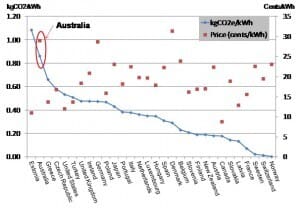Electricity prices in Australia are rising inexorably, and the the reason is not, as many would have us believe, due to support for renewable energy or the implementation of the Carbon Tax. The reasons have more to do with market dynamics than they do with any of the above, or even the wholesale cost of coal-fired electricity generation.
Australian electricity has until recently enjoyed a reputation for being some of the cheapest in the world. The usual explanation for the Lucky Country’s favourable power rates is the natural abundance of one of the least expensive power sources–coal, from which around 90% of Australia’s electricity is sourced.
A recent report (pdf) by the Energy Users Association of Australia (EUAA)–composed of 100 of Australia’s top electricity users, including BHP, Rail Corp, Coles, Commonwealth Bank, and Brisbane City Council–decries the high rates and calls on the Federal Government to take action to right the situation. Although an analysis of the EUAA report questions whether the report was not compiled with the end goal of serving its composite members’ shared goal of access to cheaper electricity rates and therefore contains cherry-picked statistics, it has managed to foster discussion as to why Australia’s electricity rates are as high as they are.
In particular, the report has prompted Climate Spectator’s Tristan Edis to discuss in detail the issue of Australia’s rising electricity prices. Despite having some of the most carbon-intensive electricity generation in the world, Australia also rather counter-intuitively has some of the most expensive electricity. The wholesale price of generating power–which hasn’t risen much in recent years–isn’t the main driver. Nor is it the much-maligned Carbon Tax (which has not yet come into effect and is not expected to have a major impact on prices), or even Federal and State Government subsidy support for renewable energy. In fact, there are plenty of other countries with more aggressive renewable energy policy and lower electricity prices than Australia.

This leads one to wonder what on earth could be happening. Germany and Denmark have higher electricity rates than Australia, but electricity usage is also lower per capita thanks to more efficient usage in those nations, so the impact is not as great. Edis says that the problem lies in the way that the electricity networks are operated in Australia; that their quasi-governmental nature creates a situation where it is in the Government’s financial interest for people to use more electricity. “You’ve got government setting the rules governing these networks, and at the same time potentially profiting from rules that encourage excessive electricity demand,” he says. Reduced peak demand means reduced profit.
He also criticises the lack of transparency in electricity bills: “Well, imagine if Woolworths and Coles decided they would remove price labels from all the goods in their stores. Also, rather than giving you an itemised docket at the checkout, they instead sent you an invoice every two months with absolutely no itemisation to identify what items were costing you a lot or a little. You’d be a little bit angry wouldn’t you?” However, most Australians do pay their electricity bills without a thought as to the exact breakdown of what their money is going to.
The solutions to the problem, Edis suggests, can be found in changing the market dynamics and by altering the average Australian electricity user’s experience. First off, there should be a transparent, standardised system for payment for electricity generators who could reduce the load placed on network infrastructure during peak demand periods–when retailers make a significant proportion of their profits. (Reneweconomy’s Giles Parkinson has written about European power utilities’ battles against distributed solar PV for the same reason.) Then, on the electricity user’s side, there should be a roll-out of interactive smart-meters that give real-time data on electricity usage and rates, so that homes and businesses can keep accurate track of their electricity costs and manage usage accordingly. This could be coupled with higher peak-time electricity rates, so that there is a clear price signal and disincentive to use power at peak times. This would help to reduce overall demand, and would have the ultimate result of reducing electricity bills.
All of the above would require an entirely new approach to the way that Australians use electricity, but it is clear that things are not functioning in their current state. Distributed generation in the form of small-scale solar and wind could also play a role in bringing down the cost of electricity for individual homes and businesses.
© 2012 Solar Choice Pty Ltd
- Solar Power Wagga Wagga, NSW – Compare outputs, returns and installers - 13 March, 2025
- Monocrystalline vs Polycrystalline Solar Panels: Busting Myths - 11 November, 2024
- Solar Hot Water System: Everything You Need to Know - 27 February, 2024